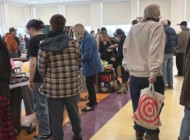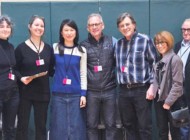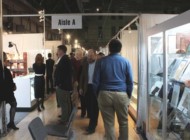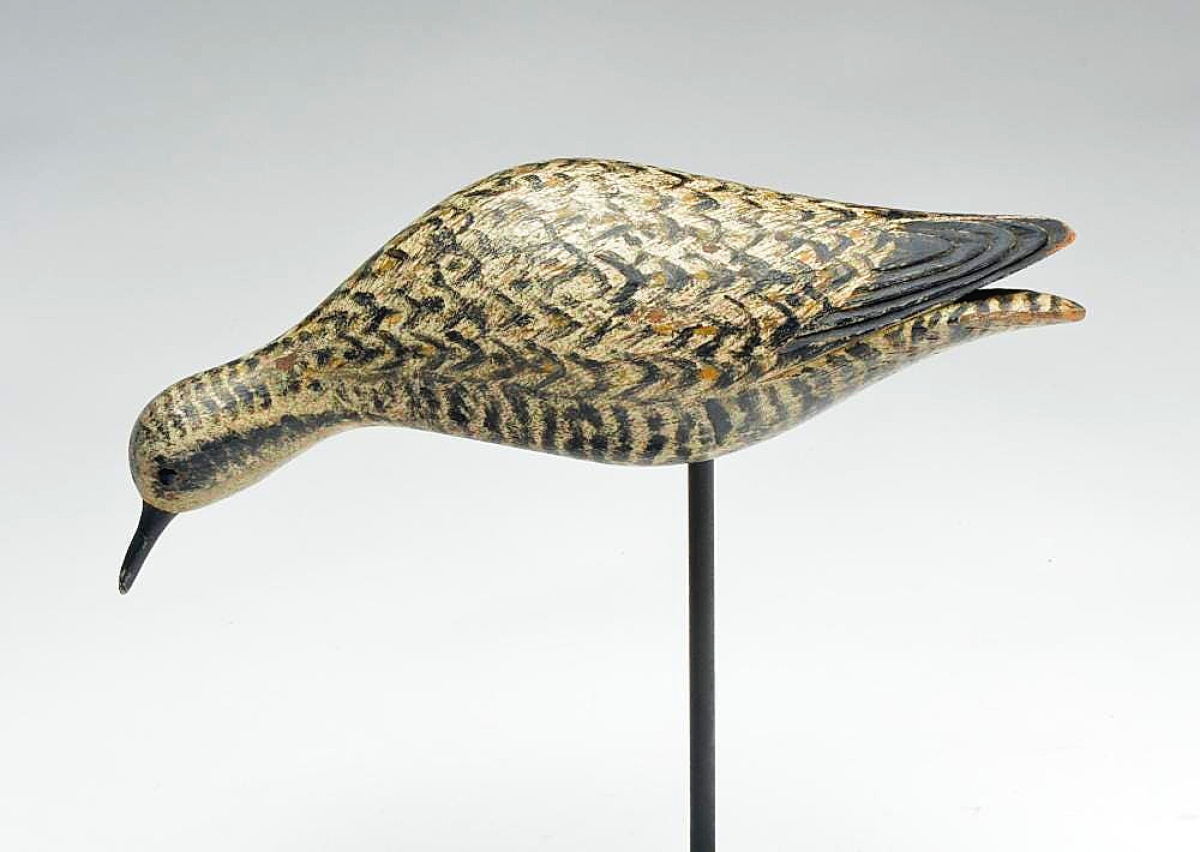
Mike Martin, Syracuse, N.Y., bought and sold this golden plover decoy by Elmer Crowell last year. He’s a believer in having a good reference library, and it probably helped with this bird. He bought it at an auction for $10,000 and sold it a few months later at another auction for $90,000.
PORTSMOUTH, N.H. – The price range of offerings at the July 17 Elks Decoy & Outdoor Sporting Collectibles Show was broad. The age of the attendees was broad, too, from mostly senior citizens to a 20-month-old infant who “really loves ducks.” Most of the inventory dealers brought were decoys used or made in New England, but not exclusively. One thing that many dealers had in common was that they themselves came to decoy collecting from backgrounds as hunters. Again, though, this was not universal. Many dealers and attendees knew one another, creating a collegial, friendly atmosphere. And if you had to pick a setting for a decoy show, this one had it all. It was conducted in an Elks lodge fronting on Sagamore creek, a tidal estuary in South Portsmouth. The terrace of the club, where free coffee was offered, overlooked the estuary.
Tom Reiley, together with some friends calling themselves the Decoy Boys Network, were the show managers. It was their first show in New Hampshire, having previously put on shows in Long Island and Connecticut. Reiley is a member of the Elks, and said he prefers to conduct his shows at Elks lodges when he can. Reiley said promoting these shows is not really a money-making proposition. “Our charge for table rentals is low and our admission charge is low. But it’s good to get people together and talk decoys, especially after the pandemic restrictions.”
The dealer with the $25,000 decoy, a redhead drake by Elmer Crowell, was Mike Martin from Syracuse, N.Y., and he represents the next generation of decoy dealers. Martin, an accountant by trade, has been buying and selling decoys for about four years. He and his wife Alyson, both 27 years old, have been married about a month, and they had some of the highest priced decoys at the show. When asked how he got started selling decoys, he said that he had been buying and selling a variety of items for a few years, and “one day when I was out looking for stuff to sell, I found this old wooden duck decoy. It was priced $100 and I bought it because the only other decoys I’d ever had seen were made of plastic. No one in my family was a hunter or a collector so that was new to me. I sold it for a profit and I was hooked. I love history, so I started to buy books on the subject, and there are a lot. I now have a library of more than 100 books, plus a number of early auction catalogs. There’s plenty of information on the internet, but nothing takes the place of books. As I learned more, I started going to the major decoy auctions and shows and met other dealers. Jon Deeter (Guyette & Deeter) was very helpful and so was Russ Goldberger. Both took the time to help me understand the differences between good, better and best in decoys.” In addition to the $25,000 decoy, Martin had numerous other decoys, including a large eider drake by an unknown maker, which was priced $5,500, and a merganser hen made by Seabrook, N.H., carver George Boyd, for which he was asking $12,000.
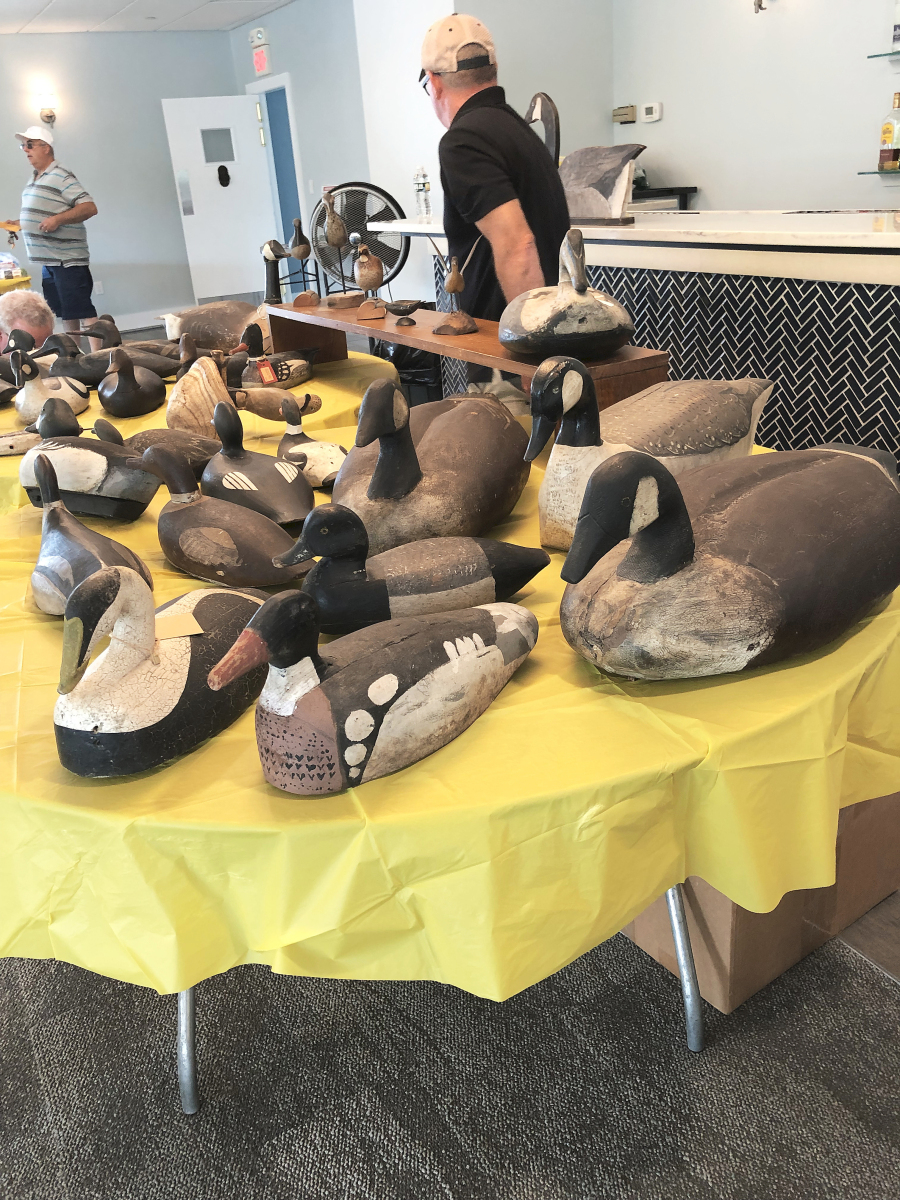
Canada geese were hunted in only one place in Maine, Merrymeeting Bay, near Bath. Byron Bruffee, Medomak Gallery, Warren, Maine, had three Canada goose decoys, one with carved wing tips. They had been made by James Scribner, and Bruffee priced them at $1,500 each.
Does studying books and auction catalogs help? Last year, Martin used his knowledge to earn a profit of about $75,000 on a feeding golden plover decoy by Crowell. He purchased it at a regional auction for about $10,000, believing it to be an exceptional decoy, and apparently his homework paid off. He consigned it to a Guyette & Deeter auction a few months later where it sold for $90,000 (both are hammer prices). When asked how he planned to use the funds, he said, “I’ve always wanted to have a winery, so Alyson and I used the money to buy 15 acres of land near Syracuse, N.Y., to make wines and ciders. The first 45 gallons we made was for our wedding in June.”
Many, but not all, of the decoys at the show were used in New England. Byron Bruffee, Medomak Gallery, Warren, Maine, was one of several dealers who had Canada goose decoys. He said that his, which were hollow-carved, had been made by James Scribner of Topsham, Maine, one of whose Canada goose decoys is in the Maine Maritime Museum. They had been used for hunting in Merrymeeting Bay, a freshwater tidal bay in Maine near Bath and Brunswick, which was the only place in Maine that Canada geese had been hunted. Bruffee said he bought them from an elderly man who had been a guide in the area for many years and they were priced at $1,500 each. Bruffee also had a decorative carving of a Eurasian jay, mounted on a chunk of tree fungus, which had been made in the Black Forest region of Switzerland or Germany. He commented that these carvings are often misidentified and sold as having originated in Pennsylvania. The price was $1,800.
Jim Jankowski, a Long Island dealer, filled a table with an assortment of decoys priced at $25 each. He said that most were Long Island birds, including scaup, broad bills and other species. Several were cork, which he said was often used in that area. He also had a cork mallard drake decoy, which had been sold by Freeport’s L.L. Bean, about 1980. Hunting supplies, especially boots, were the start of the L.L. Bean company more than 100 years ago.
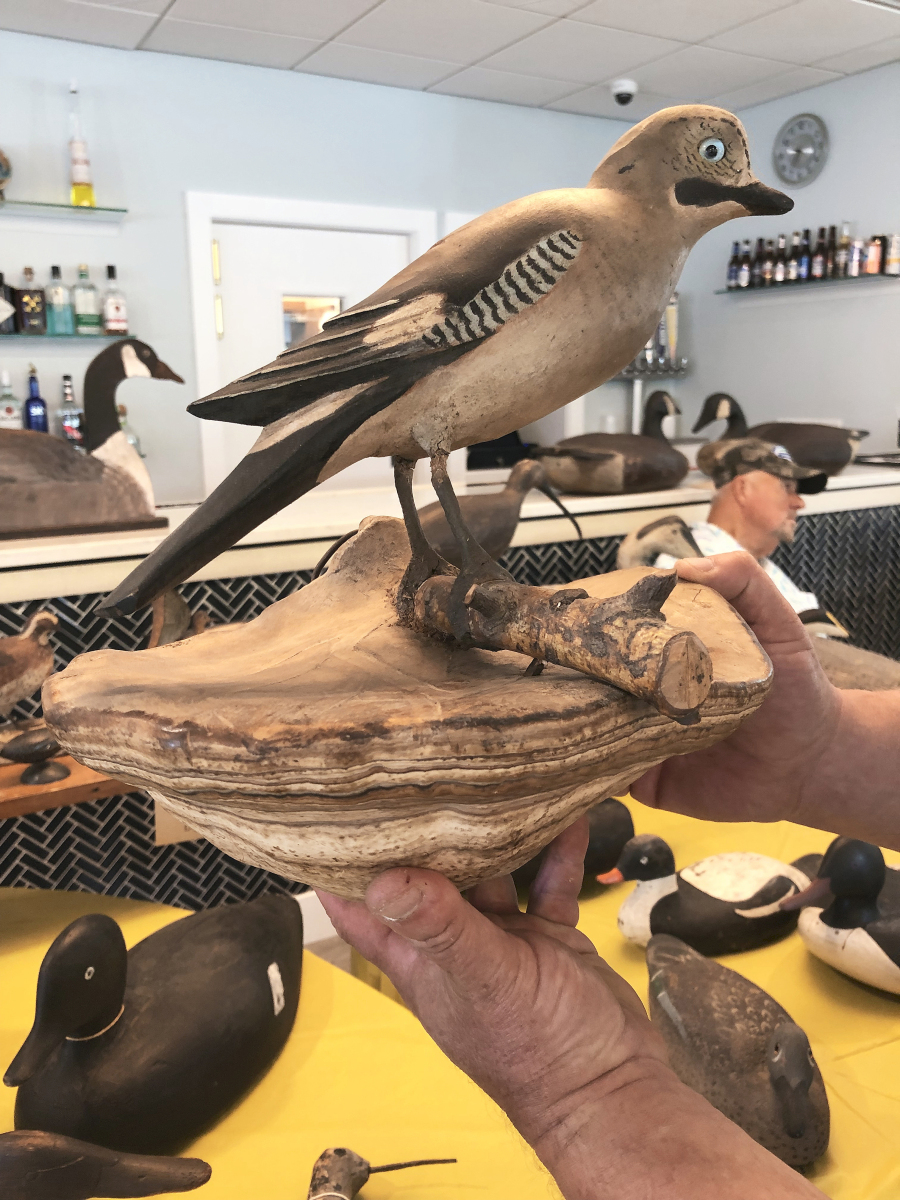
Byron Bruffee, Medomak Gallery, Warren, Maine, said that carved and painted jays like this one are sometimes sold as having originated in Pennsylvania. In fact, he said, they originated in the Black Forest region of Switzerland and Germany. This example, circa 1890, was priced at $1,800.
Tom Reiley, the show manager, also collects and deals in decoys. His offerings included a large carved and painted codfish, which he said had come from a restaurant on Cape Cod. He thought it might have hung as a trade sign and was asking $325. He also had a group of Michigan decoys, which he said he had just bought at the recent Copley decoy sale. His interest in decoys was passed down from his father, who was a gun collector.
While most of the decoys at the show had been made for hunting, Jeff Charles had a decorative carved egret with its head turned, and priced it at $200. His large scoter decoy was $150. Casey Smolla, Rowley, Mass., had a large goose decoy, which had an interesting history. Smolla said Connecticut farmers used goose decoys in their corn fields to bring the birds into shooting range, as they were a nuisance, consuming as much corn as they could. “A farmer might have two dozen or so of these geese and they never saw the water. This was one of a group found in a silo on an old farm.” He marked it $350.
Mentioned above is the importance of reliable reference material for decoy collectors and dealers. Russ Goldberger, RJG Antiques, author of one of the bestselling titles in the field, was asked which books he would suggest. He said that there are basically two types in the field: one being the books written about a specific carver or region, and the other type being the books that provide a solid overview of the field. His recommendations would include Joel Barber’s Wild Fowl Decoys, first published in 1934; Adele Earnest’s Art of The Decoy; William Mackey’s American Bird Decoys; George Starr’s Decoys of The Atlantic Flyway; and the book he wrote and published along with the late Allan Haid, Mason Decoys, A Complete Pictorial Guide. He also stressed the value of the early auction and exhibition catalogs. Goldberger, who also sells some of the books he recommended, has a website with numerous informative articles on decoy collecting.
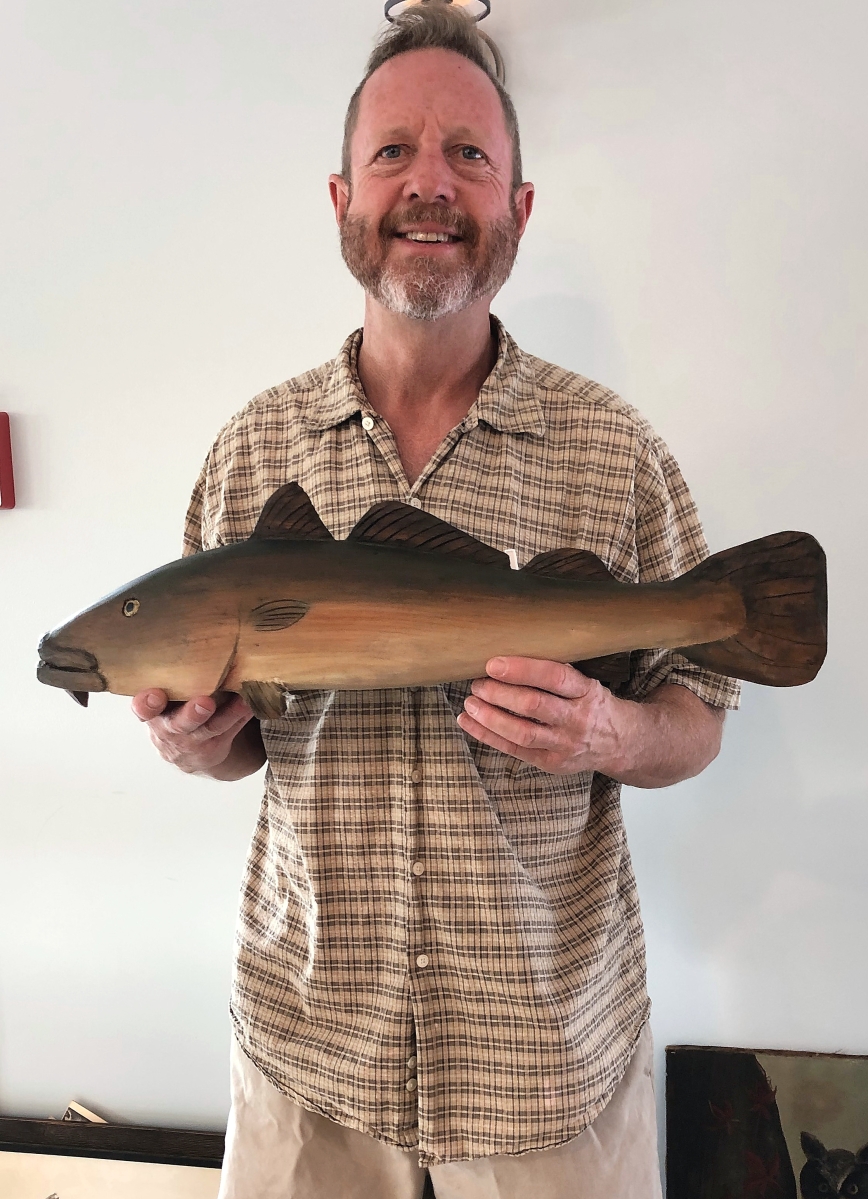
Tom Reiley, the show manager, had several decoys for sale, including this carved and painted codfish, about 2 feet long. It came from a Cape Cod restaurant where it was probably a sign, and it was priced $325.
After the show, Tom Reiley said, “The dealers did well. There were a lot of sales, and our attendance was good for a first-time show. We complied with all the New Hampshire Covid-19 regulations, and the management of the Elks lodge couldn’t have been more cooperative. The only thing that annoyed me was that one dealer chose to set up in the parking lot to avoid the table rental fee. That not only hurts me, it hurts the guys who were set up inside. Other than that, the words I’d use would have to be ‘resounding success.’ It was good to see some younger people. We’ll definitely be back at the same place on a date we haven’t worked out yet. Our next show will be October 23 in Westbrook, Conn.”
For information, 860-324-4001.



















